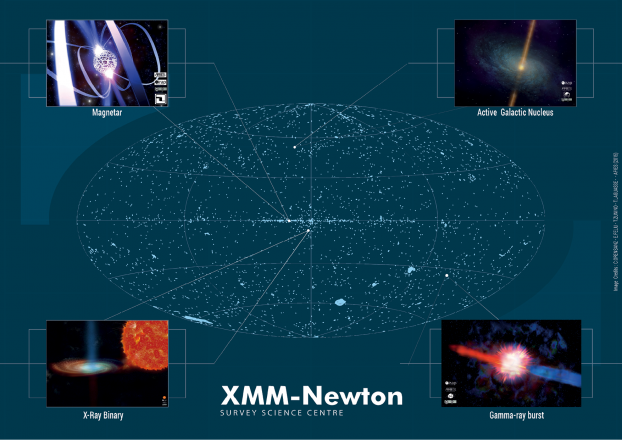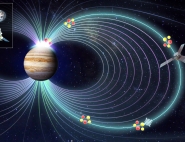Mission

Scientific Objectives
Since Earth's atmosphere blocks out all X-rays, only a telescope in space can detect and study celestial X-ray sources. The XMM-Newton mission will help scientists solve a number of cosmic mysteries, ranging from the enigmatic black holes to the origins of the Universe itself. The observing time on XMM-Newton is available to the scientific community, applying for observational periods on a competitive basis.
Thanks to its high quality focusing mirrors and battery of instruments, XMM-Newton can achieve the following objectives:
- Investigate spectra of cosmic X-ray sources with a limiting flux of 10-15 erg/cm2/s;
- Perform sensitive medium-resolution spectroscopy with resolving powers between 100 and 700 over the wavelength band 5 - 35 Å (350 - 2500 eV);
- Broad band imaging spectroscopy from 100 eV to 15 keV (0.8 - 120 Å);
- Simultaneous sensitive coverage of the wavelength band 1600 to 6000 Å through a dedicated co-aligned optical monitor.
Release of a new version of the third XMM-Newton Serendipitous Source Catalogue (3XMM-DR5) in April 2015
The fifth data release of the XMM-Newton serendipitous source catalogue (3XMM-DR5), the largest catalogue of X-ray sources ever created, contains 565 962 X-ray detections, ranging from nearby objects in our Solar System to supermassive black holes at the edge of the Universe. For each detection, a wealth of information is provided to help understand the nature of the object and as a result, many new and extreme astrophysical objects will be discovered.

New version of the third XMM-Newton Serendipitous Source Catalogue (3XMM-DR5)
The X-ray sources in the XMM-Newton serendipitous source catalogue are objects such as supermassive black holes guzzling the gas and dust that surrounds them in the centres of galaxies, exploding stars and dead stars that have collapsed to tight balls of exotic material that are as dense as the atomic nucleus and rotate up to 1000 times per second. However, new and exotic objects are expected to be found, based on results from previous smaller versions of the catalogue.
In order for scientists to benefit from the catalogue, a scientific paper was submitted to the European Journal Astronomy and Astrophysics, written by the XMM-Newton Survey Science Centre consortium, describing the catalogue and its products, along with a new version of the XMM-Newton Survey Science Centre webpages.
Read the complete Press Release
Release of the third XMM-Newton Serendipitous Source Catalogue (3XMM-DR4) (3XMM-DR4)
The release of a new catalogue from the XMM-Newton space telescope provides an unprecedented cosmic X-ray library for the exploration of the extreme Universe. The third XMM-Newton Serendipitous Source Catalogue (3XMM-DR4) contains more than half a million sources, all of which are provided to a better quality than ever before. Improved data processing means that source identification is more reliable, and fainter objects are detected.
The catalogue provides an exceptional dataset for generating large, well-defined samples of objects such as active galaxies (which dominate the detections in this catalogue), clusters of galaxies, interacting compact binaries, and active stellar coronae. This vast inventory is also home to some of the rarest and most extreme phenomena in the Universe, such as tidal disruption events–when a black hole swallows another star, producing prodigious outbursts of X-ray emission.
The sources in the 3XMM catalogue are identified and isolated from serendipitous data recorded by XMM-Newton's EPIC X-ray cameras. In each of the 600-700 observations made each year, around 70 extra sources are captured in addition to the target object which usually only takes up a small fraction of the field of view. Covering observations between February 2000 and December 2012, the catalogue contains some 531 261 X-ray source detections relating to 372 728 unique X-ray sources.
![]()
All-sky map of the third XMM-Newton Serendipitous Source Catalogue
Copyright: ESA/XMM-Newton/EPIC/M. Watson (University of Leicester)
Read the entire article on ESA's web site
Mission
XMM-Newton is ESA's second cornerstone of the Horizon 2000 Science Programme. XMM-Newton (X-ray Multi-Mirror) is a European Space Agency mission with a NASA participation. It was launched on 10 December 1999.
After launch by Ariane-5, the XMM-Newton spacecraft was placed into a 48-hour elliptical orbit around the Earth. Inclined at 40° with an apogee at 114 000 km, the perigee altitude is 7000 km.
The XMM-Newton spacecraft, with an initial two-year operational lifetime, is controlled by the European Space Operations Centre (ESOC, Darmstadt Germany) using ground stations at Perth (Australia), Kourou (French Guiana) and Santiago (Chile). The XMM-Newton Science Operations Centre situated at VILSPA in Villafranca, Spain, manages observation requests and receives XMM-Newton data. The XMM-Newton Survey Science Centre (SSC), at Leicester University UK, processes, archives and correlates all XMM-Newton observations with existing sky data held elsewhere in the world.


